Home / Deciding SN1/SN2/E1/E2 – The Solvent
SN1/SN2/E1/E2 Decision
Deciding SN1/SN2/E1/E2 – The Solvent
Last updated: August 29th, 2025 |
Secondary Alkyl Halides With Strongly Basic Nucleophiles. The “Ask Your Instructor” Edition
- In the previous four articles in this series, we covered how to identify where an SN1/SN2/E1/E2 reaction could take place, and then discussed the various roles of the substrate (primary, secondary, tertiary), the nucleophile/base, and temperature.
- We’ve seen that secondary alkyl halides with poorly basic nucleophiles (such as RS(-), N3)(-), (-)CN and halides) tend to give SN2 products, particularly in polar aprotic solvents such as dimethyl sulfoxide (DMSO), N,N-dimethylformamide (DMF), acetone, and acetonitrile.
- Following the consequences of each of these variables only leaves us with one tricky situation we need to deal with:
What about secondary alkyl halides with strongly basic nucleophiles like hydroxide (HO– ) and alkoxide (RO–).

- The chemical literature is pretty clear that these reactions result in mostly elimination (E2). Additionally, most textbooks state that elimination (E2) is favored – even in polar aprotic solvents, which tend to favor substitution reactions with poorly basic nucleophiles.
- However, that doesn’t mean that this topic is taught consistently among all schools or instructors. There are certainly examples of instructors giving exam questions where the expected answer is that this reaction gives substitution. (SN2).
- For that reason, I strongly suggest asking your instructor their opinion on what happens when a strongly basic nucleophile reacts with a secondary alkyl halide (and whether or not a polar protic or polar aprotic solvent will affect this!) and prepare accordingly.
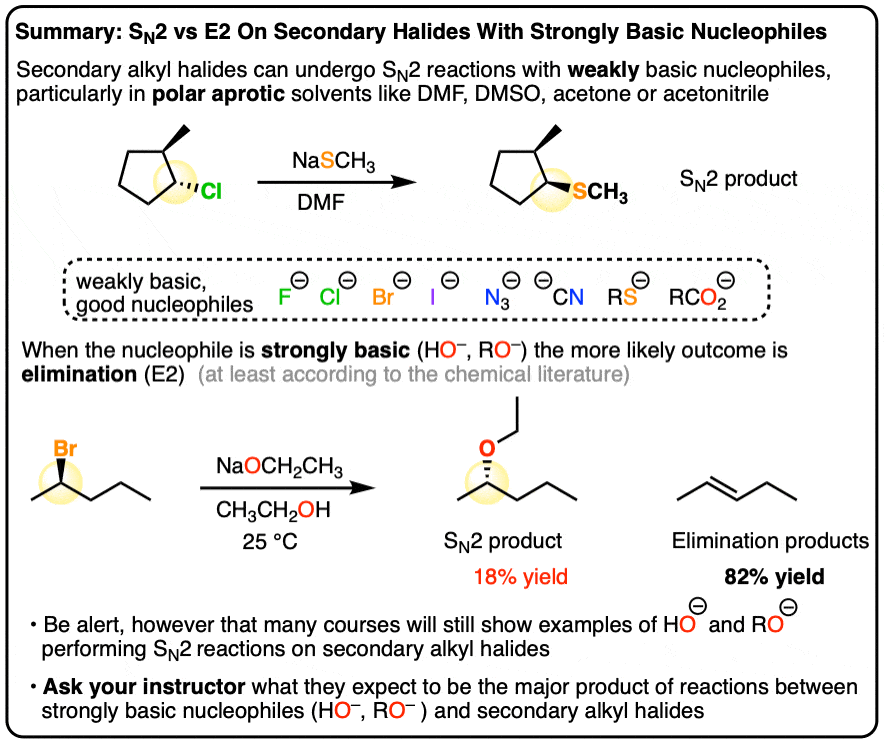
Table of Contents
1. The Question Many Instructors Avoid: Secondary Alkyl Halides With A Strongly Basic Nucleophile
You’re in an exam. You’re given the following question.
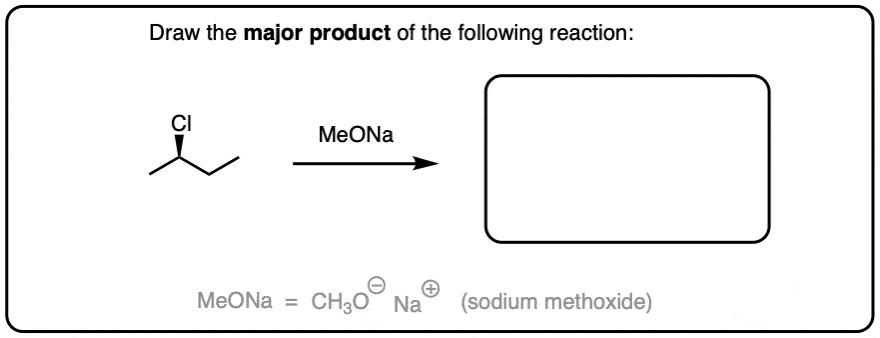
What do you draw as the answer?
Let’s start by walking through the process for narrowing down whether a reaction is SN1/SN2/E1/E2:
- LG – Identify a good leaving group (Cl)
- sp3 – Ensure that it’s on an sp3-hybridized carbon (it is)
- 123– Identify that carbon as primary, secondary or tertiary (secondary). This doesn’t rule out anything.
- N – the nucleophile is NaOCH3 (sodium methoxide). It’s a strong nucleophile due to the negative charge on oxygen, but also a strong base. (For our purposes, anything equally basic to HO(-) or RO(-) qualifies as a strong base. That rules out SN1/E1
- T – the temperature is not indicated. If heat were indicated, elimination would be likely.
Since SN1 and E1 have been ruled out, we’re left with SN2 and E2 here. We have no further clues.
What’s the product?
- If the question is, “what would happen in an actual reaction flask”, the answer is elimination (E2). [Ref] How would you know this? You would have to be told explicitly either by your instructor or by your textbook, because this is an experimental observation, not something that could be predicted from first principles.
- If the question is, “what answer would you give on an exam?” then I would say, “ask your instructor, because the answer to this specific type question is not always taught consistently. It could be SN2 or E2.”
As far as the way that organic chemistry is taught in North America, there is no greater question I know of that has as much variance as the question of “secondary alkyl halide with strongly basic nucleophile”.
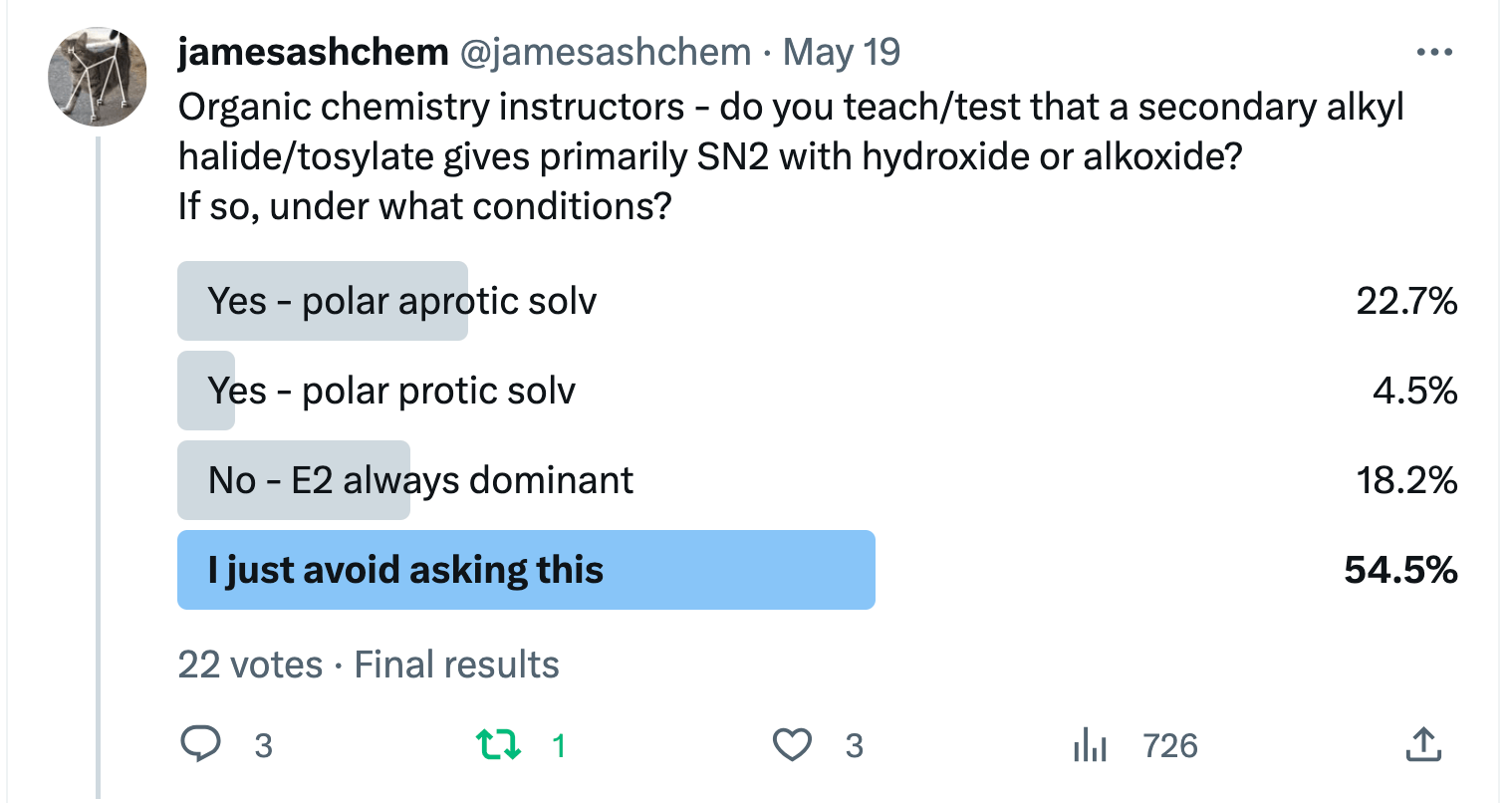
Small sample size, maybe, but there’s a lot of variation in the answers. And many instructors just flat-out avoid asking this question.
Welcome to the “ask your instructor” edition of the SN1/SN2/E1/E2 decision!
2. What Do Experiments Say? (E2!)
When I was just starting grad school, I was trying to do a substitution reaction (SN2) on a secondary alkyl halide as part of my research project with a fairly basic nucleophile (a Gilman reagent, to be precise).
My product was almost exclusively elimination (E2). Very little of my desired SN2 product was formed.
When I showed the results to my boss, his reaction was “yeah, the SN2 is a pretty crappy reaction on secondary alkyl halides”.
This initially came as a shock. After all, I’d spent so much time in sophomore organic chemistry learning the various factors that determined whether a reaction was SN1/SN2/E1/E2. Surely they wouldn’t spend all this time teaching us the SN2 if it wasn’t useful in the real world, would they?
Well… yes. In the real world, the SN2 can be a great reaction for primary alkyl halides, but for secondary alkyl halides, it only tends to work well if the nucleophile is poorly basic, like RS(-), N3(-), (-)CN, and halide ions. We covered this in the post on nucleophiles – see article. In addition, a polar aprotic solvent like DMF (N,N-dimethylformamide), DMSO (dimethyl sulfoxide), acetonitrile or acetone will assist the rate of SN2 reactions.
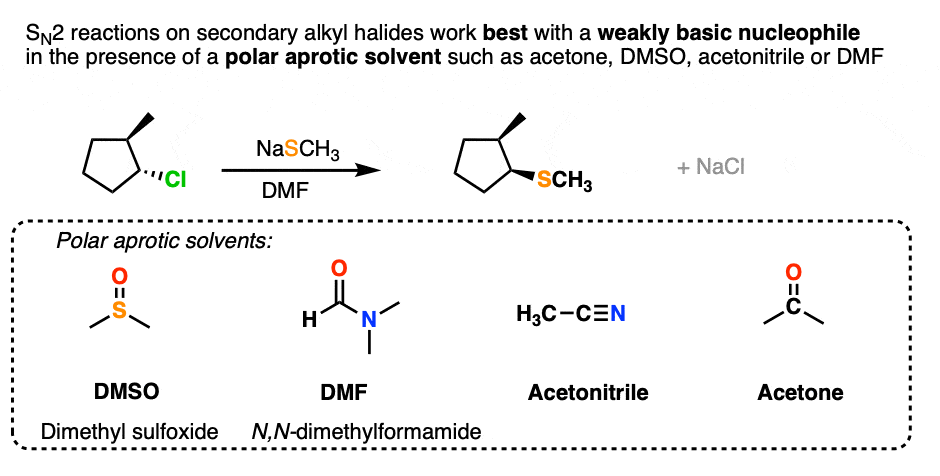
However, as soon as the nucleophile becomes strongly basic (such as with alkoxides, hydroxide, and acetylides, or Gilman reagents) elimination (E2) becomes the dominant pathway.
Here is the results of an early study on 2-bromopentane. [Ref]
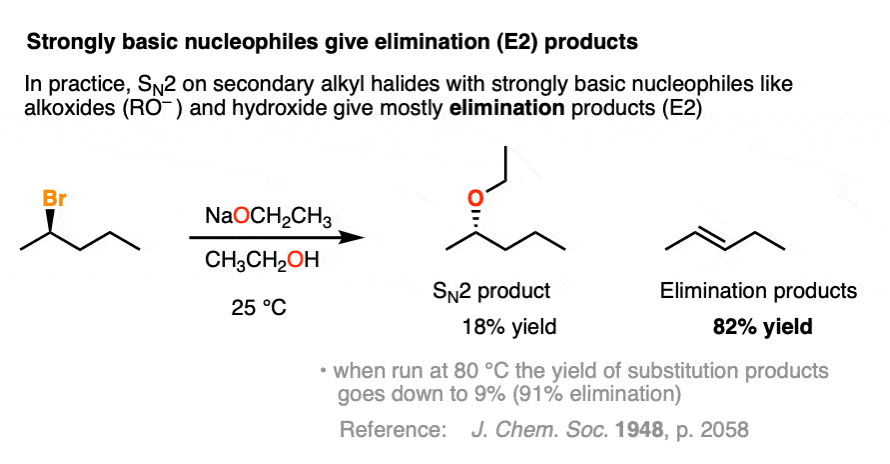
Even at room temperature it’s 82% alkene (elimination). As the temperature is increased, the proportion of elimination products also increases. (See article – Elimination Reactions Are Favored By Heat).
The absolute best case I could find was isopropyl bromide with sodium ethoxide in ethanol / H2O, which gives a 47% yield of SN2 product (and only 21% in pure ethanol).
This is as good as it gets!
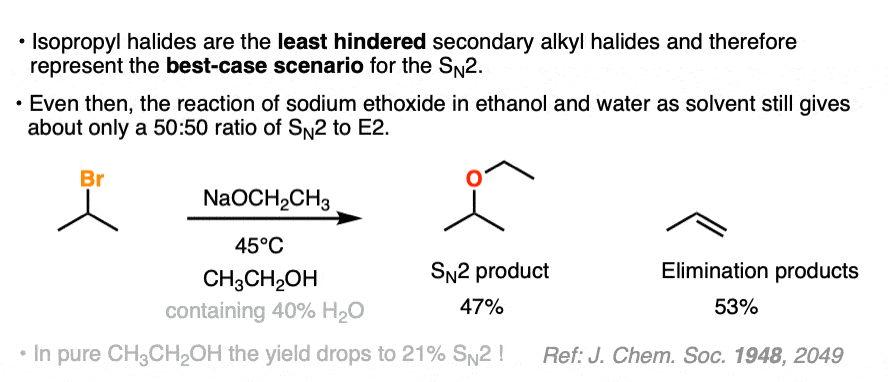
Even changing out one of the methyl groups for ethyl (i.e. to make 2-bromobutane) makes the yield drop considerably to the 20% range.
Cyclic alkyl halides aren’t any better. Cyclohexyl bromide, for example, gives about a 1% yield of SN2 product:
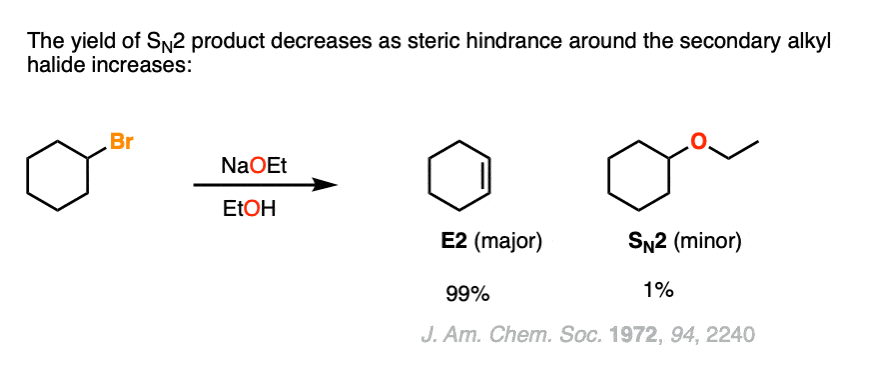
You might think you can improve the yield of SN2 by using a polar aprotic solvent like dimethyl sulfoxide (DMSO). But in that case the yield of substitution product drops from 47% (in ethanol/H2O) to about 3%.
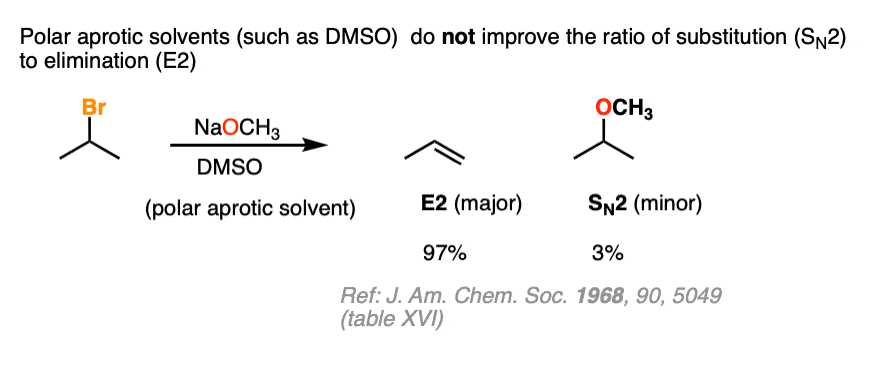
The bottom line here is that yes, indeed, reactions of secondary alkyl halides with hydroxide and alkoxides give predominantly E2 products. [Note 1]
3. What Do The Textbooks Say? (E2… mostly)
Given to the amount of angst that SN1/SN2/E1/E2 questions cause students in introductory organic chemistry, one might reasonably expect that the issue of competing SN2/E2 reactions with secondary alkyl halides would get significant coverage.
From what I see, textbooks do not discuss this issue in any great depth. It gets a sentence, or perhaps a short paragraph.
Here’s what some of the more popular organic chemistry textbooks have to say on the topic of “secondary alkyl halide + strongly basic nucleophile”.
- Klein (1st, p. 378) – E2 (major), SN2 (minor). “When the substrate is both a strong nucleophile and a strong base, bimolecular mechanisms will dominate (SN2 and E2).”
- McMurry (OpenStax): For secondary alkyl halides… E2 elimination predominates if a strong base is used. Reference
- Clayden – shows a chart where strongly basic, unhindered nucleophiles (e.g. RO(-) ) give E2. Weakly basic nucleophiles (e.g. RS(-) give SN2).
- Solomons (12th) – E2 major. “With secondary halides, however, a strong base favors elimination because steric hindrance in the substrate makes substitution more difficult.” Gives the example of isopropyl bromide with NaOH. 79% E2, 21% SN2.
- Wade (8th, p. 272) – “with a strong base, either the SN2 or E2 reaction are possible”. Nothing more specific than that.
- Streitweiser (4th ed. p. 232) – gives an example (secondary alkyl halide with alkoxide) that gives an 85:5 ratio of E2 to SN2.
So from this relatively small sample, textbooks generally say that secondary + strongly basic nucleophile favors E2, but there is a considerable amount of hedging.
4. Clear Up This Question With Your Instructor Ahead of Time
Instructors want to see that you understand that SN2 reactions result in inversion of configuration.
For that reason, expect to see examples of SN2 reactions on secondary alkyl halides containing a chiral center.
Hopefully, they’ll do this using questions involving a poorly basic nucleophile like RS(-), N3(-), (-)CN or a halide.
But they might not! Be prepared for a situation where the use hydroxide or an alkoxide to demonstrate this point:
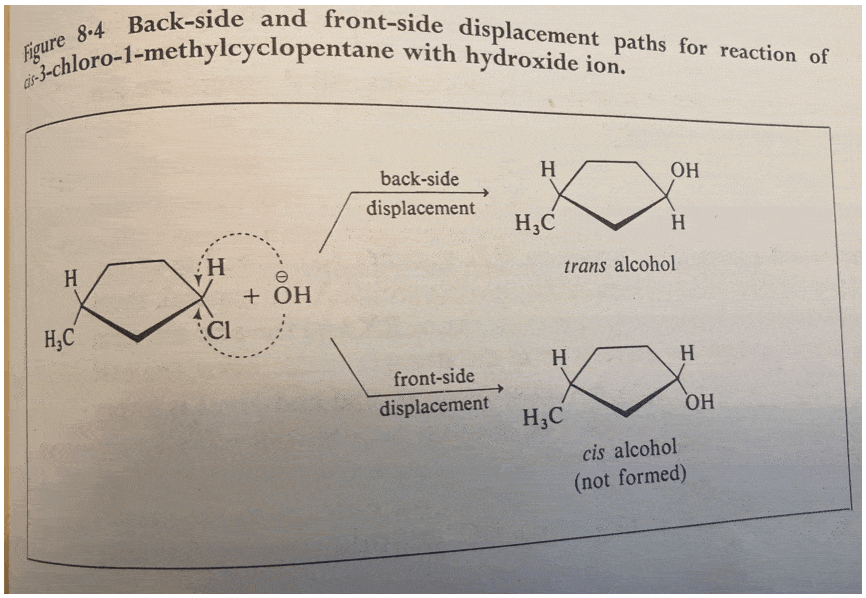
This is from “Organic Chemistry” by John D. Roberts et. al., 1971. I love John Roberts (the father of NMR), but question the choice of nucleophile to demonstrate SN2 here.
Despite the fact that the literature is pretty unambiguous that E2 is dominant, and textbooks are generally on the side of E2, sometimes instructors don’t explicitly tell you whether or not E2 or SN2 is favored for cases with a secondary alkyl halide and a strongly basic nucleophile.
That means you might have to guess the product on your own.
You should ask your instructor ahead of time whether or not reactions like the ones below give predominantly E2 or SN2 products.
Here’s the first example. Substitution or elimination?
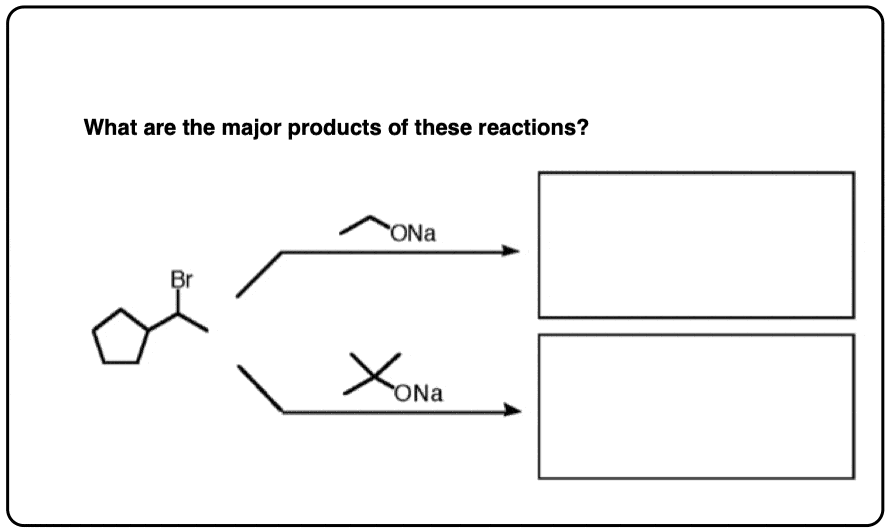
The bulky base (t-butoxide) tends to only give SN2 with methyl halides, but you should get a definitive answer from your instructor on the expected product with ethoxide. (The answer key gave both answers as elimination).
Another example. Substitution or elimination as major product?
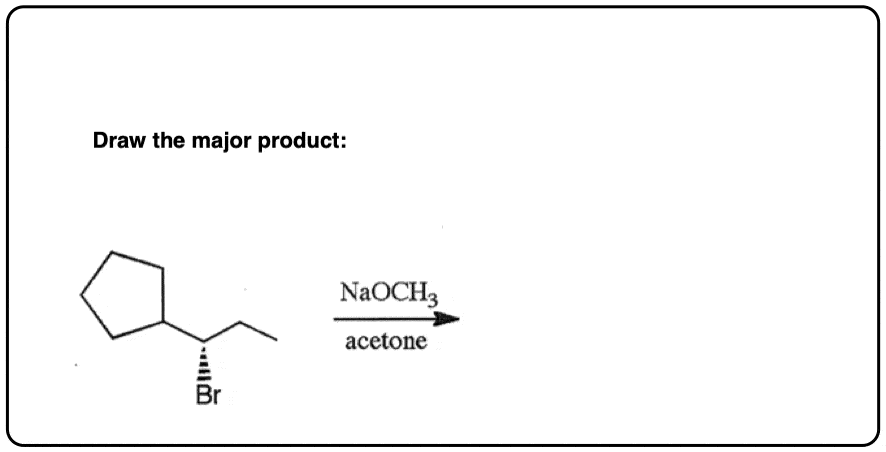
In this case the stereochemistry of the leaving group is specified, and the solvent is polar aprotic (acetone). If you weren’t told ahead of time that these reactions favor elimination, there’s a good case to be made that this could be SN2. (The answer key said E2). Check this with your instructor!
Below is another example where the stereochemistry is specified. Is this substitution or elimination?
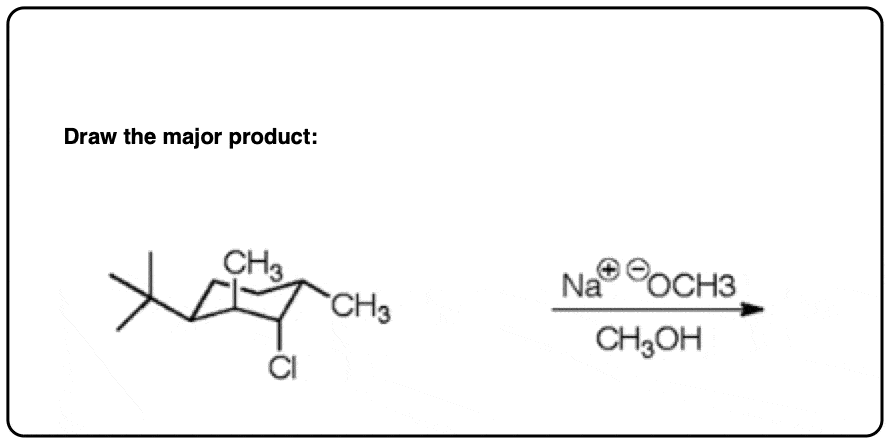
In this case the answer key also said elimination.
5. Summary: All I Can Really Say Is, “Ask Your Instructor”.
At some point before your big midterm on substitution vs elimination reactions, you should try to pin down your instructor on this question.
“Is SN2 ever the major product with a strongly basic nucleophile like hydroxide or alkoxide?”.
A simple, one-sentence question. Feel free to use any of the examples in this section to make your point.
That way, at least you’ll be told explicitly what to expect.
Notes
Related Articles
- Deciding SN1/SN2/E1/E2 (4) – The Temperature
- Identifying Where Substitution and Elimination Reactions Happen
- Polar Protic? Polar Aprotic? Nonpolar? All About Solvents
- Deciding SN1/SN2/E1/E2 (1) – The Substrate
- Deciding SN1/SN2/E1/E2 (2) – The Nucleophile/Base
- What Makes A Good Nucleophile?
- What makes a good leaving group?
- Steric Hindrance is Like a Fat Goalie
- SN1 SN2 E1 E2 Practice Problems
- Wrapup: The Quick N’ Dirty Guide To SN1/SN2/E1/E2
In previous versions of this article, I have said that secondary alkyl halides with strongly basic nucleophiles tend to give SN2 products with polar aprotic solvents. After doing a deep dive into the old chemical literature, I find that there is really zero evidence for this view. Therefore, I am now advising that the major products of these reactions should be E2 in all circumstances. For not having fixed this earlier, I apologize.
Note 1. One example that does work for the formation of ethers on secondary alkyl halides, but kind of a special case, is here.
It works because RO(-) is the conjugate base of phenol (pKa = 10) which is roughly as acidic as a thiol. So elimination isn’t as much of a concern as it would be with the more basic hydroxide and alkoxide ions.
Note 2. Table of results from a 1948 study by Ingold et. al. The results are not presented in a way that is easy to digest, but the key value is top left, where isopropyl bromide at 45°C in 60% EtOH/40% H2O gives a mixture that is 53% alkene (olefin) and presumably 47% substitution product. All other results with isopropyl halides are worse.
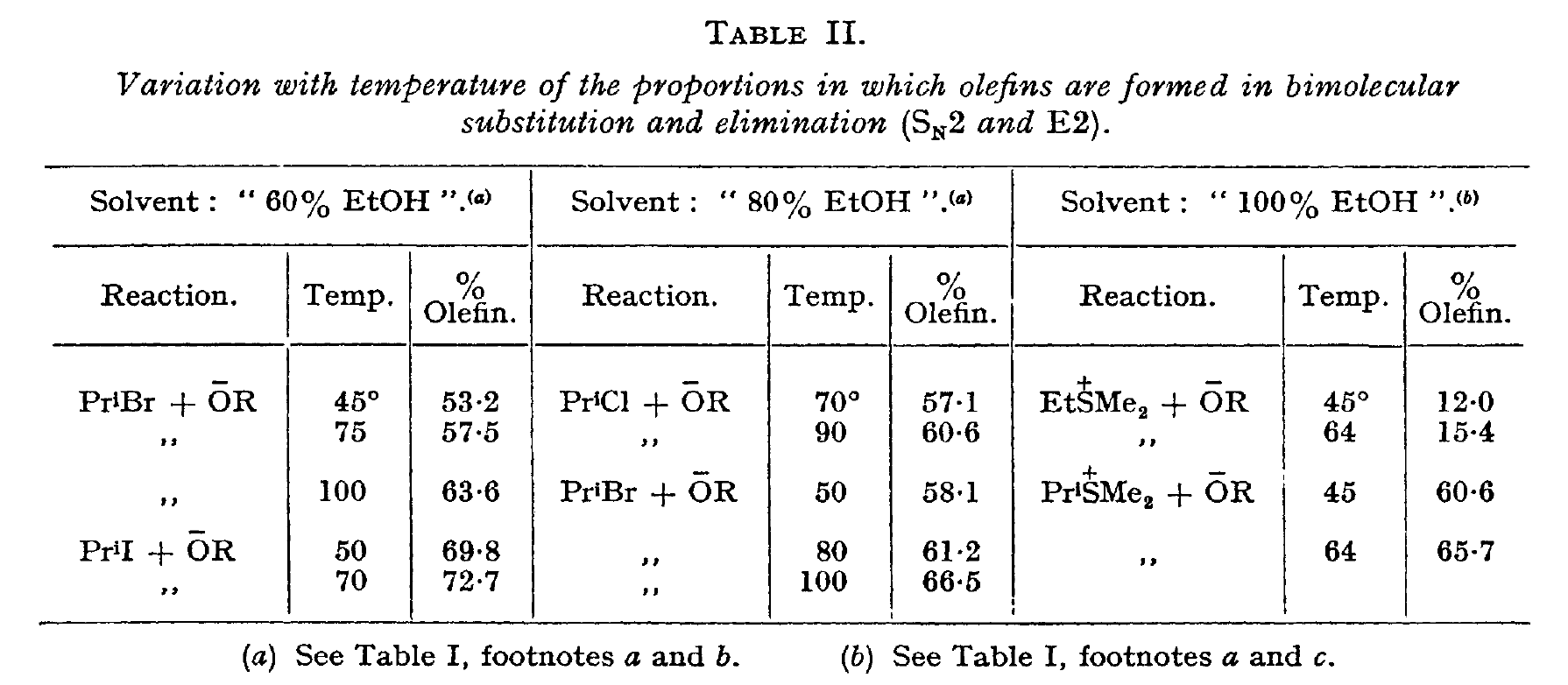
Quiz Yourself!
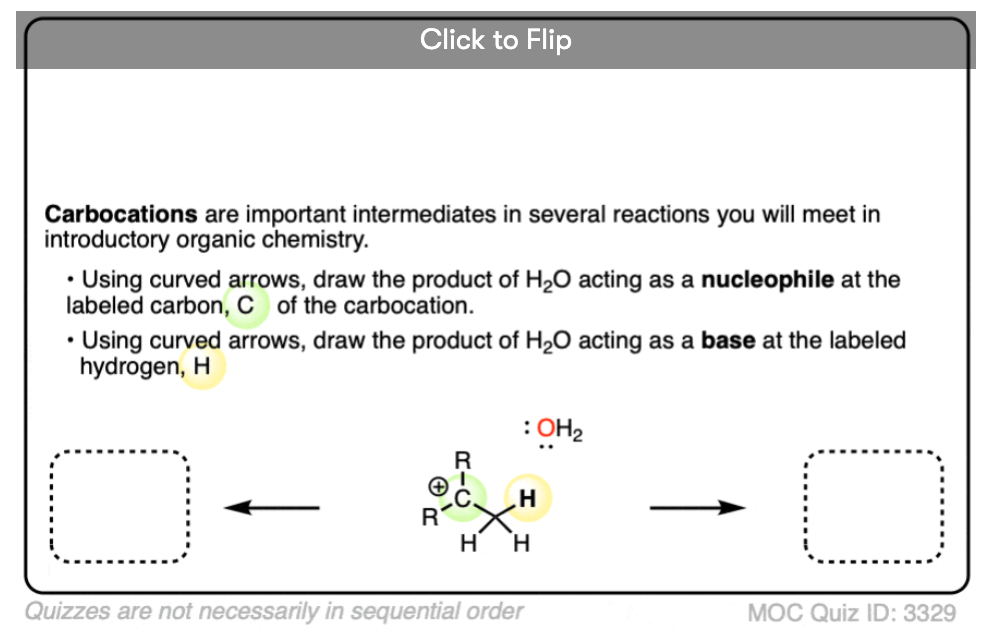
Become a MOC member to see the clickable quiz with answers on the back.
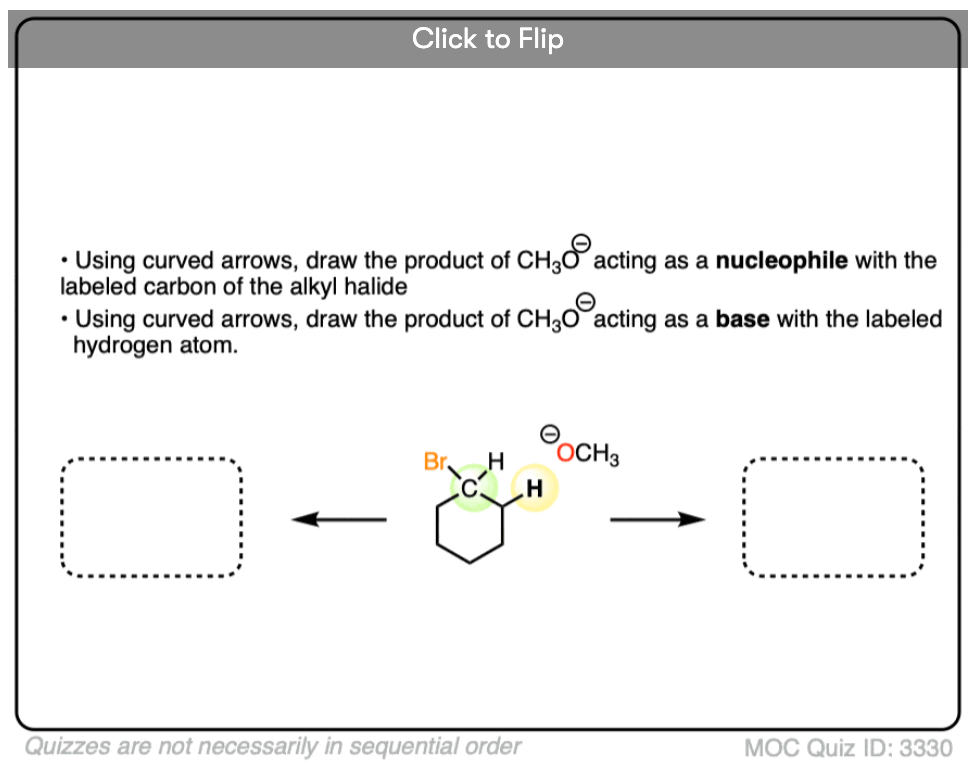
Become a MOC member to see the clickable quiz with answers on the back.
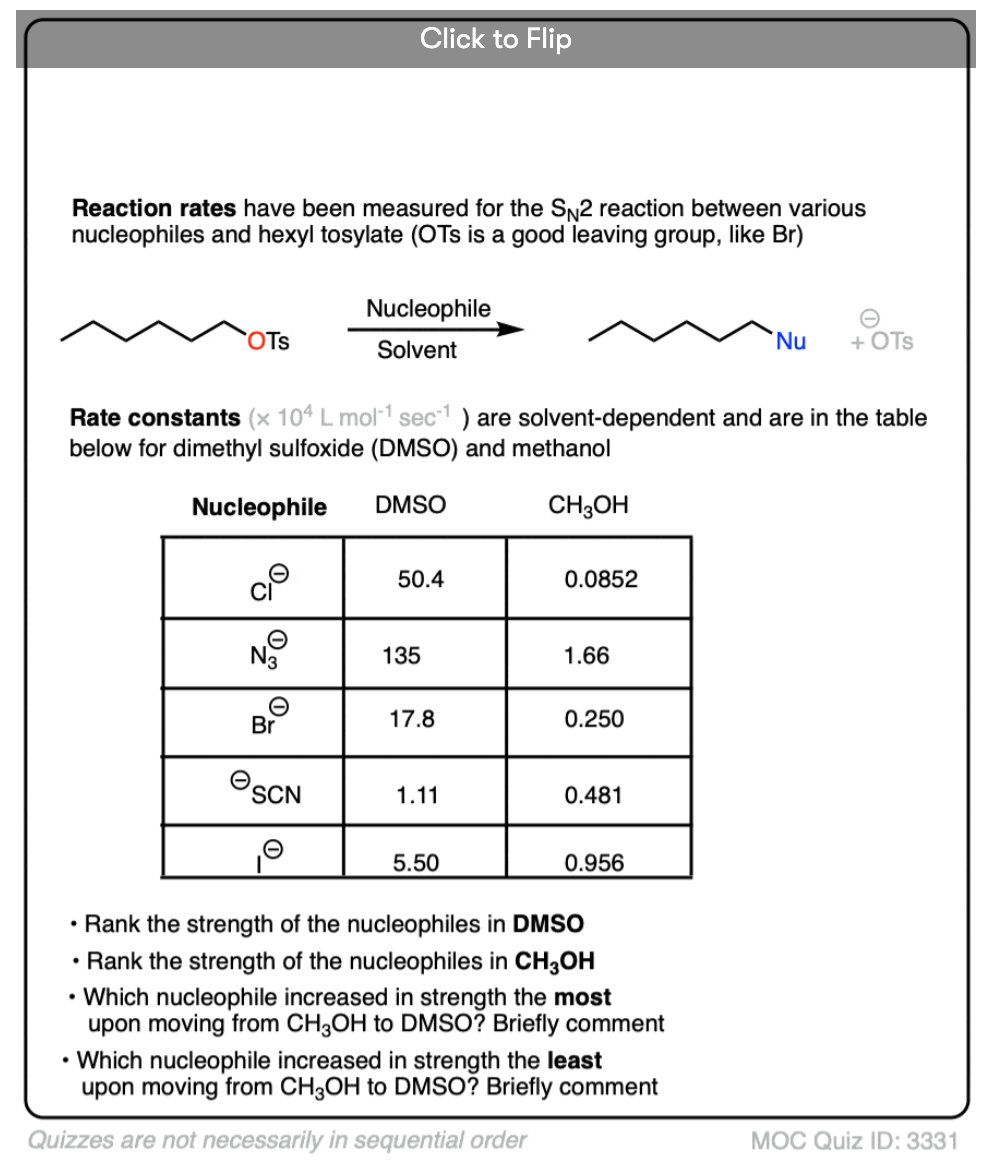
Become a MOC member to see the clickable quiz with answers on the back.
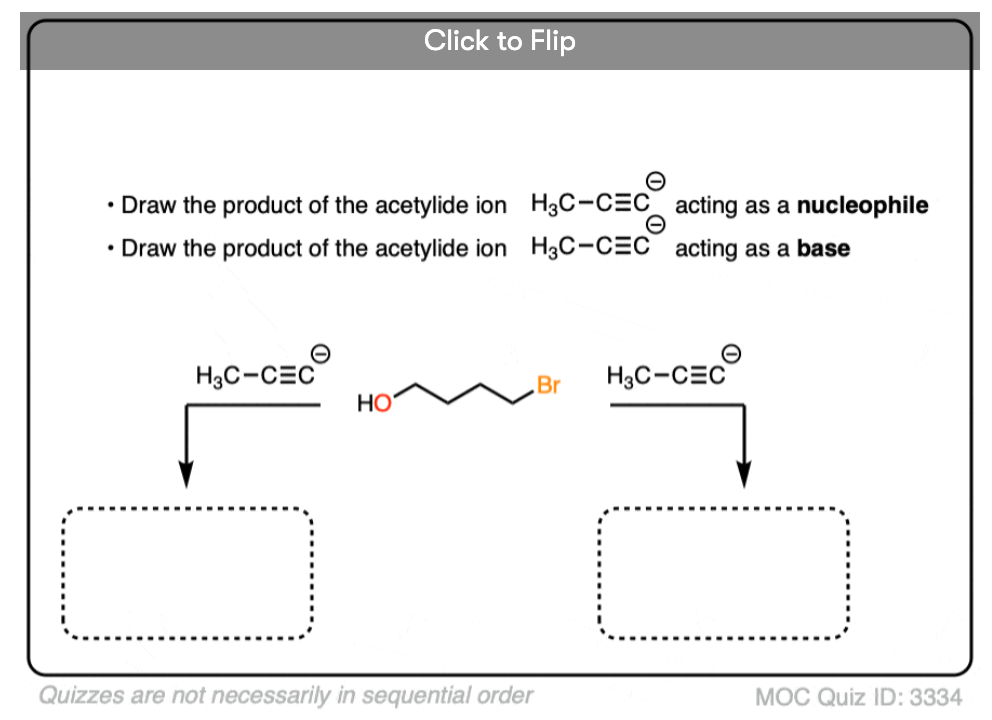
Become a MOC member to see the clickable quiz with answers on the back.
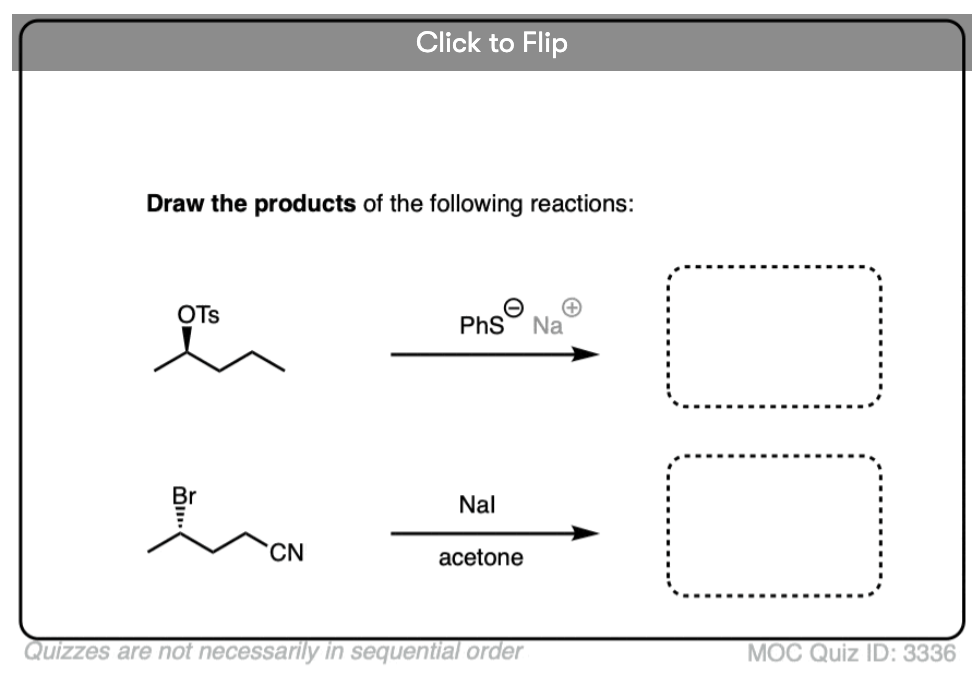
Become a MOC member to see the clickable quiz with answers on the back.
(Advanced) References and Further Reading
- Mechanism of elimination reactions. Part VII. Solvent effects on rates and product-proportions in uni- and bi-molecular substitution and elimination reactions of alkyl halides and sulphonium salts in hydroxylic solvents
K. A. Cooper, M. L. Dhar, E. D. Hughes, C. K. Ingold, B. J. MacNulty and L. I. Woolf
J. Chem. Soc. 1948, 2043-2049
DOI: 10.1039/JR9480002043
For the reaction of isopropyl bromide with hydroxide ion in ethanol at 55°C, the reaction gives 29% SN2 products and 71% E2 products (see table V). (The amount of SN2 can be increased to 46% by adding 40% H2O by volume). - Mechanism of elimination reactions. Part X. Kinetics of olefin elimination from isopropyl, sec.-butyl, 2-n-amyl, and 3-n-amyl bromides in acidic and alkaline alcoholic media
M. L. Dhar, E. D. Hughes and C. K. Ingold
J. Chem. Soc. 1948, 2058-2065
DOI: 10.1039/JR9480002058
This article studies the SN2/E2 ratios of various secondary alkyl halides such as 2-bromobutane and 2-bromopentane and finds that they almost exclusively (>80%) give E2 products. - The Reaction of Primary and Secondary Alkylaryl and Alkyl Sulfonates with Potassium t-Butoxide in Dimethyl Sulfoxide
Carl H. Snyder and Aida R. Soto
The Journal of Organic Chemistry 1964 29 (3), 742-745
DOI: 10.1021/jo01026a055
Study on SN2/E2 ratios in primary and secondary alkyl sulfonates. In this article the authors state that essentially no SN2 products are isolated from the reaction of secondary alkyl sulfonates (e.g. ROTs) with KOtBu in dimethyl sulfoxide. - Hydroxide-Promoted Elimination Reactions: Alkyl Halides as Substrates†
Manfred Schlosser, Claudio Tarchini
Helvetica Chim. Acta. 1977, 60, 3060-3068
DOI: 10.1002/hlca.19770600858.
Secondary alkyl halides are shown as giving almost exclusively elimination products here. - Solvation of ions. XIV. Protic-dipolar aprotic solvent effects on rates of bimolecular reactions. Solvent activity coefficients of reactants and transition states at 25°.
R. Alexander, E. C. F. Ko, A. J. Parker, and T. J. Broxton
Journal of the American Chemical Society 1968 90 (19), 5049-5069
DOI: 10.1021/ja01021a002
Rates of 78 SN2 and E2 reactions for primary and secondary alkyl halides in various solvents. In this article the yield of the SN2 reaction of isopropyl bromide with NaOCH3 in DMSO is given as 3% as measured by vapor phase chromatography (97% elimination). - How Alkyl Halide Structure Affects E2 and SN2 Reaction Barriers: E2 Reactions Are as Sensitive as SN2 Reactions
Paul R. Rablen, Brett D. McLarney, Brandon J. Karlow, and Jean E. Schneider
The Journal of Organic Chemistry 2014 79 (3), 867-879
DOI: 10.1021/jo4026644
A more recent article about competition between SN2 and E2 reactions. - https://www.sciencedirect.com/science/article/abs/pii/S0040402001972503
00 General Chemistry Review
01 Bonding, Structure, and Resonance
- How Do We Know Methane (CH4) Is Tetrahedral?
- Hybrid Orbitals and Hybridization
- How To Determine Hybridization: A Shortcut
- Orbital Hybridization And Bond Strengths
- Sigma bonds come in six varieties: Pi bonds come in one
- Dipole Moments and Dipoles
- A Key Skill: How to Calculate Formal Charge
- The Four Intermolecular Forces and How They Affect Boiling Points
- 3 Trends That Affect Boiling Points
- How To Use Electronegativity To Determine Electron Density (and why NOT to trust formal charge)
- Introduction to Resonance
- How To Use Curved Arrows To Interchange Resonance Forms
- Evaluating Resonance Forms (1) - The Rule of Least Charges
- How To Find The Best Resonance Structure By Applying Electronegativity
- Evaluating Resonance Structures With Negative Charges
- Evaluating Resonance Structures With Positive Charge
- Exploring Resonance: Pi-Donation
- Exploring Resonance: Pi-acceptors
- In Summary: Evaluating Resonance Structures
- Drawing Resonance Structures: 3 Common Mistakes To Avoid
- How to apply electronegativity and resonance to understand reactivity
- Bond Hybridization Practice
- Structure and Bonding Practice Quizzes
- Resonance Structures Practice
02 Acid Base Reactions
- Introduction to Acid-Base Reactions
- Acid Base Reactions In Organic Chemistry
- The Stronger The Acid, The Weaker The Conjugate Base
- Walkthrough of Acid-Base Reactions (3) - Acidity Trends
- Five Key Factors That Influence Acidity
- Acid-Base Reactions: Introducing Ka and pKa
- How to Use a pKa Table
- The pKa Table Is Your Friend
- A Handy Rule of Thumb for Acid-Base Reactions
- Acid Base Reactions Are Fast
- pKa Values Span 60 Orders Of Magnitude
- How Protonation and Deprotonation Affect Reactivity
- Acid Base Practice Problems
03 Alkanes and Nomenclature
- Meet the (Most Important) Functional Groups
- Condensed Formulas: Deciphering What the Brackets Mean
- Hidden Hydrogens, Hidden Lone Pairs, Hidden Counterions
- Don't Be Futyl, Learn The Butyls
- Primary, Secondary, Tertiary, Quaternary In Organic Chemistry
- Branching, and Its Affect On Melting and Boiling Points
- The Many, Many Ways of Drawing Butane
- Wedge And Dash Convention For Tetrahedral Carbon
- Common Mistakes in Organic Chemistry: Pentavalent Carbon
- Table of Functional Group Priorities for Nomenclature
- Summary Sheet - Alkane Nomenclature
- Organic Chemistry IUPAC Nomenclature Demystified With A Simple Puzzle Piece Approach
- Boiling Point Quizzes
- Organic Chemistry Nomenclature Quizzes
04 Conformations and Cycloalkanes
- Staggered vs Eclipsed Conformations of Ethane
- Conformational Isomers of Propane
- Newman Projection of Butane (and Gauche Conformation)
- Introduction to Cycloalkanes
- Geometric Isomers In Small Rings: Cis And Trans Cycloalkanes
- Calculation of Ring Strain In Cycloalkanes
- Cycloalkanes - Ring Strain In Cyclopropane And Cyclobutane
- Cyclohexane Conformations
- Cyclohexane Chair Conformation: An Aerial Tour
- How To Draw The Cyclohexane Chair Conformation
- The Cyclohexane Chair Flip
- The Cyclohexane Chair Flip - Energy Diagram
- Substituted Cyclohexanes - Axial vs Equatorial
- Ranking The Bulkiness Of Substituents On Cyclohexanes: "A-Values"
- Cyclohexane Chair Conformation Stability: Which One Is Lower Energy?
- Fused Rings - Cis-Decalin and Trans-Decalin
- Naming Bicyclic Compounds - Fused, Bridged, and Spiro
- Bredt's Rule (And Summary of Cycloalkanes)
- Newman Projection Practice
- Cycloalkanes Practice Problems
05 A Primer On Organic Reactions
- The Most Important Question To Ask When Learning a New Reaction
- Curved Arrows (for reactions)
- Nucleophiles and Electrophiles
- The Three Classes of Nucleophiles
- Nucleophilicity vs. Basicity
- What Makes A Good Nucleophile?
- What Makes A Good Leaving Group?
- 3 Factors That Stabilize Carbocations
- Equilibrium and Energy Relationships
- 7 Factors that stabilize negative charge in organic chemistry
- 7 Factors That Stabilize Positive Charge in Organic Chemistry
- What's a Transition State?
- Hammond's Postulate
- Learning Organic Chemistry Reactions: A Checklist (PDF)
06 Free Radical Reactions
- Free Radical Reactions
- 3 Factors That Stabilize Free Radicals
- Bond Strengths And Radical Stability
- Free Radical Initiation: Why Is "Light" Or "Heat" Required?
- Initiation, Propagation, Termination
- Monochlorination Products Of Propane, Pentane, And Other Alkanes
- Selectivity In Free Radical Reactions
- Selectivity in Free Radical Reactions: Bromination vs. Chlorination
- Halogenation At Tiffany's
- Allylic Bromination
- Bonus Topic: Allylic Rearrangements
- In Summary: Free Radicals
- Synthesis (2) - Reactions of Alkanes
- Free Radicals Practice Quizzes
07 Stereochemistry and Chirality
- Types of Isomers: Constitutional Isomers, Stereoisomers, Enantiomers, and Diastereomers
- How To Draw The Enantiomer Of A Chiral Molecule
- How To Draw A Bond Rotation
- Introduction to Assigning (R) and (S): The Cahn-Ingold-Prelog Rules
- Assigning Cahn-Ingold-Prelog (CIP) Priorities (2) - The Method of Dots
- Enantiomers vs Diastereomers vs The Same? Two Methods For Solving Problems
- Assigning R/S To Newman Projections (And Converting Newman To Line Diagrams)
- How To Determine R and S Configurations On A Fischer Projection
- The Meso Trap
- Optical Rotation, Optical Activity, and Specific Rotation
- Optical Purity and Enantiomeric Excess
- What's a Racemic Mixture?
- Chiral Allenes And Chiral Axes
- Stereochemistry Practice Problems and Quizzes
08 Substitution Reactions
- Nucleophilic Substitution Reactions - Introduction
- Two Types of Nucleophilic Substitution Reactions
- The SN2 Mechanism
- Why the SN2 Reaction Is Powerful
- The SN1 Mechanism
- The Conjugate Acid Is A Better Leaving Group
- Comparing the SN1 and SN2 Reactions
- Polar Protic? Polar Aprotic? Nonpolar? All About Solvents
- Steric Hindrance is Like a Fat Goalie
- Common Blind Spot: Intramolecular Reactions
- Substitution Practice - SN1
- Substitution Practice - SN2
09 Elimination Reactions
- Elimination Reactions (1): Introduction And The Key Pattern
- Elimination Reactions (2): The Zaitsev Rule
- Elimination Reactions Are Favored By Heat
- Two Elimination Reaction Patterns
- The E1 Reaction
- The E2 Mechanism
- E1 vs E2: Comparing the E1 and E2 Reactions
- Antiperiplanar Relationships: The E2 Reaction and Cyclohexane Rings
- Bulky Bases in Elimination Reactions
- Comparing the E1 vs SN1 Reactions
- Elimination (E1) Reactions With Rearrangements
- E1cB - Elimination (Unimolecular) Conjugate Base
- Elimination (E1) Practice Problems And Solutions
- Elimination (E2) Practice Problems and Solutions
10 Rearrangements
11 SN1/SN2/E1/E2 Decision
- Identifying Where Substitution and Elimination Reactions Happen
- Deciding SN1/SN2/E1/E2 (1) - The Substrate
- Deciding SN1/SN2/E1/E2 (2) - The Nucleophile/Base
- SN1 vs E1 and SN2 vs E2 : The Temperature
- Deciding SN1/SN2/E1/E2 - The Solvent
- Wrapup: The Key Factors For Determining SN1/SN2/E1/E2
- Alkyl Halide Reaction Map And Summary
- SN1 SN2 E1 E2 Practice Problems
12 Alkene Reactions
- E and Z Notation For Alkenes (+ Cis/Trans)
- Alkene Stability
- Alkene Addition Reactions: "Regioselectivity" and "Stereoselectivity" (Syn/Anti)
- Stereoselective and Stereospecific Reactions
- Hydrohalogenation of Alkenes and Markovnikov's Rule
- Hydration of Alkenes With Aqueous Acid
- Rearrangements in Alkene Addition Reactions
- Halogenation of Alkenes and Halohydrin Formation
- Oxymercuration Demercuration of Alkenes
- Hydroboration Oxidation of Alkenes
- m-CPBA (meta-chloroperoxybenzoic acid)
- OsO4 (Osmium Tetroxide) for Dihydroxylation of Alkenes
- Palladium on Carbon (Pd/C) for Catalytic Hydrogenation of Alkenes
- Cyclopropanation of Alkenes
- A Fourth Alkene Addition Pattern - Free Radical Addition
- Alkene Reactions: Ozonolysis
- Oxidative Cleavage of Vicinal Diols With NaIO4 and Pb(OAc)4
- Summary: Three Key Families Of Alkene Reaction Mechanisms
- Synthesis (4) - Alkene Reaction Map, Including Alkyl Halide Reactions
- Alkene Reactions Practice Problems
13 Alkyne Reactions
- Acetylides from Alkynes, And Substitution Reactions of Acetylides
- Partial Reduction of Alkynes With Lindlar's Catalyst
- Partial Reduction of Alkynes With Na/NH3 To Obtain Trans Alkenes
- Alkyne Hydroboration With "R2BH"
- Hydration and Oxymercuration of Alkynes
- Hydrohalogenation of Alkynes
- Alkyne Halogenation: Bromination and Chlorination of Alkynes
- Oxidation of Alkynes With O3 and KMnO4
- Alkenes To Alkynes Via Halogenation And Elimination Reactions
- Alkynes Are A Blank Canvas
- Synthesis (5) - Reactions of Alkynes
- Alkyne Reactions Practice Problems With Answers
14 Alcohols, Epoxides and Ethers
- Alcohols - Nomenclature and Properties
- Alcohols Can Act As Acids Or Bases (And Why It Matters)
- Alcohols - Acidity and Basicity
- The Williamson Ether Synthesis
- Ethers From Alkenes, Tertiary Alkyl Halides and Alkoxymercuration
- Alcohols To Ethers via Acid Catalysis
- Cleavage Of Ethers With Acid
- Epoxides - The Outlier Of The Ether Family
- Opening of Epoxides With Acid
- Epoxide Ring Opening With Base
- Making Alkyl Halides From Alcohols
- Tosylates And Mesylates
- PBr3 and SOCl2
- Elimination Reactions of Alcohols
- Elimination of Alcohols To Alkenes With POCl3
- Alcohol Oxidation: "Strong" and "Weak" Oxidants
- Demystifying The Mechanisms of Alcohol Oxidations
- Protecting Groups For Alcohols
- Thiols And Thioethers
- Calculating the oxidation state of a carbon
- Oxidation and Reduction in Organic Chemistry
- Oxidation Ladders
- SOCl2 Mechanism For Alcohols To Alkyl Halides: SN2 versus SNi
- Alcohol Reactions Roadmap (PDF)
- Alcohol Reaction Practice Problems
- Epoxide Reaction Quizzes
- Oxidation and Reduction Practice Quizzes
15 Organometallics
- What's An Organometallic?
- Formation of Grignard and Organolithium Reagents
- Organometallics Are Strong Bases
- Reactions of Grignard Reagents
- Protecting Groups In Grignard Reactions
- Synthesis Problems Involving Grignard Reagents
- Grignard Reactions And Synthesis (2)
- Organocuprates (Gilman Reagents): How They're Made
- Gilman Reagents (Organocuprates): What They're Used For
- The Heck, Suzuki, and Olefin Metathesis Reactions (And Why They Don't Belong In Most Introductory Organic Chemistry Courses)
- Reaction Map: Reactions of Organometallics
- Grignard Practice Problems
16 Spectroscopy
- Degrees of Unsaturation (or IHD, Index of Hydrogen Deficiency)
- Conjugation And Color (+ How Bleach Works)
- Introduction To UV-Vis Spectroscopy
- UV-Vis Spectroscopy: Absorbance of Carbonyls
- UV-Vis Spectroscopy: Practice Questions
- Bond Vibrations, Infrared Spectroscopy, and the "Ball and Spring" Model
- Infrared (IR) Spectroscopy: A Quick Primer On Interpreting Spectra
- IR Spectroscopy: 4 Practice Problems
- 1H NMR: How Many Signals?
- Homotopic, Enantiotopic, Diastereotopic
- Diastereotopic Protons in 1H NMR Spectroscopy: Examples
- 13-C NMR - How Many Signals
- Liquid Gold: Pheromones In Doe Urine
- Natural Product Isolation (1) - Extraction
- Natural Product Isolation (2) - Purification Techniques, An Overview
- Structure Determination Case Study: Deer Tarsal Gland Pheromone
17 Dienes and MO Theory
- What To Expect In Organic Chemistry 2
- Are these molecules conjugated?
- Conjugation And Resonance In Organic Chemistry
- Bonding And Antibonding Pi Orbitals
- Molecular Orbitals of The Allyl Cation, Allyl Radical, and Allyl Anion
- Pi Molecular Orbitals of Butadiene
- Reactions of Dienes: 1,2 and 1,4 Addition
- Thermodynamic and Kinetic Products
- More On 1,2 and 1,4 Additions To Dienes
- s-cis and s-trans
- The Diels-Alder Reaction
- Cyclic Dienes and Dienophiles in the Diels-Alder Reaction
- Stereochemistry of the Diels-Alder Reaction
- Exo vs Endo Products In The Diels Alder: How To Tell Them Apart
- HOMO and LUMO In the Diels Alder Reaction
- Why Are Endo vs Exo Products Favored in the Diels-Alder Reaction?
- Diels-Alder Reaction: Kinetic and Thermodynamic Control
- The Retro Diels-Alder Reaction
- The Intramolecular Diels Alder Reaction
- Regiochemistry In The Diels-Alder Reaction
- The Cope and Claisen Rearrangements
- Electrocyclic Reactions
- Electrocyclic Ring Opening And Closure (2) - Six (or Eight) Pi Electrons
- Diels Alder Practice Problems
- Molecular Orbital Theory Practice
18 Aromaticity
- Introduction To Aromaticity
- Rules For Aromaticity
- Huckel's Rule: What Does 4n+2 Mean?
- Aromatic, Non-Aromatic, or Antiaromatic? Some Practice Problems
- Antiaromatic Compounds and Antiaromaticity
- The Pi Molecular Orbitals of Benzene
- The Pi Molecular Orbitals of Cyclobutadiene
- Frost Circles
- Aromaticity Practice Quizzes
19 Reactions of Aromatic Molecules
- Electrophilic Aromatic Substitution: Introduction
- Activating and Deactivating Groups In Electrophilic Aromatic Substitution
- Electrophilic Aromatic Substitution - The Mechanism
- Ortho-, Para- and Meta- Directors in Electrophilic Aromatic Substitution
- Understanding Ortho, Para, and Meta Directors
- Why are halogens ortho- para- directors?
- Disubstituted Benzenes: The Strongest Electron-Donor "Wins"
- Electrophilic Aromatic Substitutions (1) - Halogenation of Benzene
- Electrophilic Aromatic Substitutions (2) - Nitration and Sulfonation
- EAS Reactions (3) - Friedel-Crafts Acylation and Friedel-Crafts Alkylation
- Intramolecular Friedel-Crafts Reactions
- Nucleophilic Aromatic Substitution (NAS)
- Nucleophilic Aromatic Substitution (2) - The Benzyne Mechanism
- Reactions on the "Benzylic" Carbon: Bromination And Oxidation
- The Wolff-Kishner, Clemmensen, And Other Carbonyl Reductions
- More Reactions on the Aromatic Sidechain: Reduction of Nitro Groups and the Baeyer Villiger
- Aromatic Synthesis (1) - "Order Of Operations"
- Synthesis of Benzene Derivatives (2) - Polarity Reversal
- Aromatic Synthesis (3) - Sulfonyl Blocking Groups
- Birch Reduction
- Synthesis (7): Reaction Map of Benzene and Related Aromatic Compounds
- Aromatic Reactions and Synthesis Practice
- Electrophilic Aromatic Substitution Practice Problems
20 Aldehydes and Ketones
- What's The Alpha Carbon In Carbonyl Compounds?
- Nucleophilic Addition To Carbonyls
- Aldehydes and Ketones: 14 Reactions With The Same Mechanism
- Sodium Borohydride (NaBH4) Reduction of Aldehydes and Ketones
- Grignard Reagents For Addition To Aldehydes and Ketones
- Wittig Reaction
- Hydrates, Hemiacetals, and Acetals
- Imines - Properties, Formation, Reactions, and Mechanisms
- All About Enamines
- Breaking Down Carbonyl Reaction Mechanisms: Reactions of Anionic Nucleophiles (Part 2)
- Aldehydes Ketones Reaction Practice
21 Carboxylic Acid Derivatives
- Nucleophilic Acyl Substitution (With Negatively Charged Nucleophiles)
- Addition-Elimination Mechanisms With Neutral Nucleophiles (Including Acid Catalysis)
- Basic Hydrolysis of Esters - Saponification
- Transesterification
- Proton Transfer
- Fischer Esterification - Carboxylic Acid to Ester Under Acidic Conditions
- Lithium Aluminum Hydride (LiAlH4) For Reduction of Carboxylic Acid Derivatives
- LiAlH[Ot-Bu]3 For The Reduction of Acid Halides To Aldehydes
- Di-isobutyl Aluminum Hydride (DIBAL) For The Partial Reduction of Esters and Nitriles
- Amide Hydrolysis
- Thionyl Chloride (SOCl2) And Conversion of Carboxylic Acids to Acid Halides
- Diazomethane (CH2N2)
- Carbonyl Chemistry: Learn Six Mechanisms For the Price Of One
- Making Music With Mechanisms (PADPED)
- Carboxylic Acid Derivatives Practice Questions
22 Enols and Enolates
- Keto-Enol Tautomerism
- Enolates - Formation, Stability, and Simple Reactions
- Kinetic Versus Thermodynamic Enolates
- Aldol Addition and Condensation Reactions
- Reactions of Enols - Acid-Catalyzed Aldol, Halogenation, and Mannich Reactions
- Claisen Condensation and Dieckmann Condensation
- Decarboxylation
- The Malonic Ester and Acetoacetic Ester Synthesis
- The Michael Addition Reaction and Conjugate Addition
- The Robinson Annulation
- Haloform Reaction
- The Hell–Volhard–Zelinsky Reaction
- Enols and Enolates Practice Quizzes
23 Amines
- The Amide Functional Group: Properties, Synthesis, and Nomenclature
- Basicity of Amines And pKaH
- 5 Key Basicity Trends of Amines
- The Mesomeric Effect And Aromatic Amines
- Nucleophilicity of Amines
- Alkylation of Amines (Sucks!)
- Reductive Amination
- The Gabriel Synthesis
- Some Reactions of Azides
- The Hofmann Elimination
- The Hofmann and Curtius Rearrangements
- The Cope Elimination
- Protecting Groups for Amines - Carbamates
- The Strecker Synthesis of Amino Acids
- Introduction to Peptide Synthesis
- Reactions of Diazonium Salts: Sandmeyer and Related Reactions
- Amine Practice Questions
24 Carbohydrates
- D and L Notation For Sugars
- Pyranoses and Furanoses: Ring-Chain Tautomerism In Sugars
- What is Mutarotation?
- Reducing Sugars
- The Big Damn Post Of Carbohydrate-Related Chemistry Definitions
- The Haworth Projection
- Converting a Fischer Projection To A Haworth (And Vice Versa)
- Reactions of Sugars: Glycosylation and Protection
- The Ruff Degradation and Kiliani-Fischer Synthesis
- Isoelectric Points of Amino Acids (and How To Calculate Them)
- Carbohydrates Practice
- Amino Acid Quizzes
25 Fun and Miscellaneous
- A Gallery of Some Interesting Molecules From Nature
- Screw Organic Chemistry, I'm Just Going To Write About Cats
- On Cats, Part 1: Conformations and Configurations
- On Cats, Part 2: Cat Line Diagrams
- On Cats, Part 4: Enantiocats
- On Cats, Part 6: Stereocenters
- Organic Chemistry Is Shit
- The Organic Chemistry Behind "The Pill"
- Maybe they should call them, "Formal Wins" ?
- Why Do Organic Chemists Use Kilocalories?
- The Principle of Least Effort
- Organic Chemistry GIFS - Resonance Forms
- Reproducibility In Organic Chemistry
- What Holds The Nucleus Together?
- How Reactions Are Like Music
- Organic Chemistry and the New MCAT
26 Organic Chemistry Tips and Tricks
- Common Mistakes: Formal Charges Can Mislead
- Partial Charges Give Clues About Electron Flow
- Draw The Ugly Version First
- Organic Chemistry Study Tips: Learn the Trends
- The 8 Types of Arrows In Organic Chemistry, Explained
- Top 10 Skills To Master Before An Organic Chemistry 2 Final
- Common Mistakes with Carbonyls: Carboxylic Acids... Are Acids!
- Planning Organic Synthesis With "Reaction Maps"
- Alkene Addition Pattern #1: The "Carbocation Pathway"
- Alkene Addition Pattern #2: The "Three-Membered Ring" Pathway
- Alkene Addition Pattern #3: The "Concerted" Pathway
- Number Your Carbons!
- The 4 Major Classes of Reactions in Org 1
- How (and why) electrons flow
- Grossman's Rule
- Three Exam Tips
- A 3-Step Method For Thinking Through Synthesis Problems
- Putting It Together
- Putting Diels-Alder Products in Perspective
- The Ups and Downs of Cyclohexanes
- The Most Annoying Exceptions in Org 1 (Part 1)
- The Most Annoying Exceptions in Org 1 (Part 2)
- The Marriage May Be Bad, But the Divorce Still Costs Money
- 9 Nomenclature Conventions To Know
- Nucleophile attacks Electrophile
27 Case Studies of Successful O-Chem Students
- Success Stories: How Corina Got The The "Hard" Professor - And Got An A+ Anyway
- How Helena Aced Organic Chemistry
- From a "Drop" To B+ in Org 2 – How A Hard Working Student Turned It Around
- How Serge Aced Organic Chemistry
- Success Stories: How Zach Aced Organic Chemistry 1
- Success Stories: How Kari Went From C– to B+
- How Esther Bounced Back From a "C" To Get A's In Organic Chemistry 1 And 2
- How Tyrell Got The Highest Grade In Her Organic Chemistry Course
- This Is Why Students Use Flashcards
- Success Stories: How Stu Aced Organic Chemistry
- How John Pulled Up His Organic Chemistry Exam Grades
- Success Stories: How Nathan Aced Organic Chemistry (Without It Taking Over His Life)
- How Chris Aced Org 1 and Org 2
- Interview: How Jay Got an A+ In Organic Chemistry
- How to Do Well in Organic Chemistry: One Student's Advice
- "America's Top TA" Shares His Secrets For Teaching O-Chem
- "Organic Chemistry Is Like..." - A Few Metaphors
- How To Do Well In Organic Chemistry: Advice From A Tutor
- Guest post: "I went from being afraid of tests to actually looking forward to them".
Excellent article as always James. A tiny error for you to correct – your nucleophile NaOCH3 in the 1st section should be named sodium methoxide (not potassium).
Fixed. Thanks!
In a polar protic solvent like ch3oh, och3- should be weak and do sn1 in 2 degree.. but answer is sn2..how is this possible.. pls help🙏
No, no, no.
CH3O(-) is a strong base in CH3OH (pKa of 15). I don’t know where you get the idea that it’s not.
Great update! Thank you so much! It is really interesting to see how, in reference 5, changing the solvent from a protic solvent to DMSO gives a tiny increase in amount of elimination with isopropyl bromide + methoxide. AND in this very same example the temperature is actually lower than the comparison example with protic solvent.
Some common wisdom with these reactions seems to be based on a game of telephone that has been going on for 150 years.
Relating to the last sentence I said… Alcohol Is a polar protic solvent… (but it’s less polar than water… and the textbook kept saying that a less polar solvent favours elimination…)
My last sentence more fittingly refers to the Williamson synthesis.
Sorry for the several comments, I am trawling this site for my chemistry final in 2 weeks.
Oh a couple of other people have asked about the alcoholic and aqueous KOH already-
I’ve found the source with the explanation:
https://flic.kr/p/2ogxqFf
The book says that alkoxide ion prefers to be a base rather than a nucleophile for steric reasons, as opposed to OH- which can go in for an SN2 easier.
The textbook is Pradeep’s New Course Chemistry for Class 12
So yeah, exception to polar protic solvents favouring E2 over SN2.
The second reaction tripped me up because ethoxide ion in ethanol is the usual reagent for the Williamson ether synthesis, which is an SN2 reaction.
(Not on topic, but my textbook also had something confusing about whether it’s better to have a tertiary alkyl halide substrate or a tertiary alkoxide nucleophile for that SN2 reaction…I may ask about it on the comments section of that page)
But as you say it’s not that the SN2 reaction won’t occur at all, it’s that the E2 reaction will occur in greater proportion, I guess. The Williamson page said how we get alkoxide ion from alcohol in situ with Na or NaH, and if the alkoxide ion is given beforehand, we could use a polar aprotic solvent to prevent elimination from competing.
Also, in my course we hear that aqueous KOH leads to an SN2 reaction while alcoholic KOH leads to an E2 reaction. I heard the explanation is that OH- is a good nucleophile for an SN2 reaction, and when there’s alcohol and KOH the OH- can deprotonate the alcohol to get alkoxide ion, which is a stronger base than a nucleophile, so takes a proton for an E2 reaction. Does this hold up?
Usually in the Williamson the substrate is a primary alkyl halide. When the substrate is secondary, elimination will compete.
F is a very weak nucleophile because it would rather take a H+ and leave than attack an electrophilic center. This article is incorrect in this regard. This is a special exception.
Fluoride ion (not HF) is perfectly capable of acting as a nucleophile – e.g. TBAF (tetrabutylammonium fluoride)
Can one claim that the polarity of the solvent affects also E1/SN1 ratio?
Both pathways form the same carbocation as the product of the rate-determining step. But in the second step, the solvent can interact with the (usually not charged) base-nucleophile. The higher the solvent’s polarity, the stronger the interaction (that lowers the nucleophilicity more than basicity).
Are these interactions negligible here? Does it have empirical support?
Generally, what effect the solvent has in E1/SN1 reactions?
A little doubt, if solvent consists of Ch3O- ions and Ch3Oh the reaction will be Sn1 or Sn2?
CH3O(-) is a strong nucleophile, and therefore it will be either SN2 or E2.
My question is if polar protic solvents favour E2 over SN2 then why does a alkyl halide when reacted with aq KOH give alcohol as a major product , even though H20 is a more stronger protic solvent than alcoholic media.Even if it isn’t strong , it is still protic so it shouldn’t give SN2 , but it does !!🤔
Primary or secondary alkyl halide? Because if it’s primary, it should have been clear from the start that it’s an SN2. The real question is what happens with secondary alkyl halides. There is vast inconsistency in how instructors handle this, so I strongly suggest SN2 for polar aprotic solvents, and E2 for polar protic.
Thanks a lot !
Glad you found it helpful.
Thanks a lot James for giving us concepts for free what our Professors themselves are confused about. Will you please do us a favour by creating a post on ( though not related to this topic) electrophilic aromatic substitution in disubstituted benzene rings…. I am confused over the exceptional cases.
EAS in disubstituted rings: https://www.masterorganicchemistry.com/2018/03/19/eas-disubstituted-benzenes/
My prof told me that polar protic solvent will favour sn1 reaction because it solvates the carbocation thus increasing the stability. Any comment?
Yes, that is the case, and is consistent with the text of this post.
But what if CN WITH POLAR PROTIC SOLVENT AND NO HEAT
Anytime you see the cyanide anion you’re likely looking at a nucleophilic substitution.
Thank you soo much ! This website has been soo helpful!!
Glad you liked it!
A question on number 2 above – why isn’t E1 with hydride shift possible?
Because of the presence of the strong base KOEt.This will lead to an E2 reaction. If it were just EtOH, then yes, E1 with hydride shift is a possibility.
than why does water, even though being a polar protic solvent favour sn2 mechanism.
Example:
CH3ChHBrCHH3 +OH-(AQ.) = CH3CHOHCH3 (SN2)
CH3CHBrCH3 + OH-(ALCOHOLIC) = CH3CHCH2 (E2 ELIMINATION)
Where are you getting this from?
is it true that polar aprotic solvents are not used in SN1 reactions because some of them can react with the carbocation intermediate and give an unwanted product. Rather, polar protic solvents are preferred ? how eh ?
Polar aprotic solvents cannot react with the carbocation intermediate. Rather, polar protic solvents are used because they are generally more polar than polar aprotic solvents.
I am confused. I thought protic solvents favored sn1/e1 over sn2/e2 vs aprotic solvents favoring e2/sn2 rxns over e1/sn1. Why is that you have compared sn2/e2 here for “protic” solvents than sn1/e1?
I encourage you to go back and read the two previous posts. This is the third in a series of posts on how to deduce SN1/SN2/E1/E2 by asking 4 questions. In the first post we looked at the substrate, and said that tertiary substrates were most likely to undergo sn1/e1 and primary substrates the least likely to undergo sn1/e1. In the second post, we examined the nucleophile, and said that charged nucleophiles/bases would favor sn2/e2 and uncharged nucleophiles would favour sn1/e1. Just by answering those two questions, you can determine whether the reaction will be sn1/e1 or sn2/e2 for most cases. In this third post we show how sn2/e2 can be distinguished in the case of secondary alkyl halides: polar protic solvents tend to favor e2 moreso than sn2.
This post was very helpful, but an answer from my lecturer about this confused me. The reaction was a primary haloalkane with NaOH, with water as the solvent. I thought that since water is obviously a polar protic solvent, an E2 reaction would be favoured, but my lecturer told me that the reaction is Sn2. Now I’m really confused. Any explanation?
If it’s a primary alkyl halide, it’s almost certainly SN2. the only exception would be if you have an extremely bulky base/nucleophile like t-BuO- , and then, possibly, you might get elimination (e2)
Hi! I’m a sophomore chem major who is currently in organic chemistry, and I just wanted to say thanks for this resource! I studied this stuff for ages but couldn’t get it to all line up correctly in my head. This gave me a great frame of reference and an excellent systematic approach with which to approach these problems, which was just what I needed. ^^ Thanks again! You may have earned me ten points on my final!
Thanks Kayleigh! So glad you’ve found this website useful! James
Dear James,
I’ve been getting conflicting information from different sources, or maybe I’m just not interpreting it correctly. From what you say here, when the situation is set up for a bimolecular reaction, a polar aprotic solvent will favor SN2 and protic will favor E2. However I have also seen sources that list polar aprotic as a “good” solvent for E2, and this makes sense to me, because with a protic solvent wouldn’t you run the risk of protonating the base before it can abstract the beta-H?
I think the same question! But I guess the effect of polar protic solvents on the nucleophiles will be much more severe than that on the bases. Is that right?
Yes! The nucleophile is attacking carbon here (specifically orbitals on carbon) which are much more difficult to access (and thus sensitive to steric hindrance) than the 1s orbital on a hydrogen [ie when something acts as a Bronsted acid]
Thank you very much for this. Honestly, I chose this over Khan Academy (mainly because I’m in quite a rush to learn this before an exam and you gave a wonderful yet concise explanation). I honestly preferred this over Khan Academy and even the 2nd language book for organic chemistry. I definitely plan on recommending this to classmates and even to my professor so that he may recommend it to future students. Cheers!
Yes!!!!! I completely agree!!! Love this site and I have already told my classmates about it! Thanks so much!!! So helpful and I love how you use funny pictures and explanations, stuff sticks better that way! Orgo final tomorrow!
great blog, I have learned a lot, thanks for all of your hard work, if I may ask a question though, I am sure I am just missing this but WHY are polar protic solvents preferred for E2? I would think that there are a bunch of H+ floating around and for E2 we need a strong base, that this would bind to the protons before ever reaching the nucleophile?
My thoughts exactly!
It’s not so much that polar protic solvents are preferred for E2, it’s that polar protic solvents are less favoured for SN2. Polar protic solvents lead to hydrogen bonding of the nucleophile, which you can think of as making the nucleophile more “sterically hindered”. Since nucleophilic substitution is more sensitive to steric hindrance than acid-base reactions (i.e. attacking the H of the C-H bond) a polar protic solvent will tend to decrease the rate of substitution (relative to elimination) .
In a situation where both reactions compete (e.g. secondary alkyl halide with a strong base like NaOH) this can be the difference between favouring substitution (SN2) vs favouring elimination (E2).
My Organic Chem Prof said this is wrong. Polar protic solvents slow down second order reactions because Protic solvents weaken bases and Nucleophiles.
E2 and Sn2 are favoured by polar aprotic i think that’s a mistake question 2 can’t be E2 it is E 1
Please post the next installment soon!!
2 comments :)
-I think it may be important to say that in the truly ‘toss up’ cases (like #2 above), if we ran the reaction and analyzed the results by, say, GC/MS (something we do in our ugrad OChem labs… tho not for this reaction), we’d probably see BOTH E2 and SN2 products… but with protic solvents the E2 is the major organic product, and with aprotic solvents the SN2 is the major organic product. It’s not as if one solvent gives 100% of elimination, and another solvent gives 100% of substitution.
-I also have my students analyze the reactions in this way. What does the nucleophile tell us? What does the electrophile tell us? What does the solvent tell us? I use these to generate ‘evidence for’ a mechanism, or ‘evidence against’ a mechanism.
That’s my comment. I would hesitate to use a phrase like ‘rule out’ since psychologically that’s exclusionary thinking. I could conjure up an example where the evidence from the nucleophile ‘rules out’ an SN2 mechanism… but based on the other evidence SN2 is exactly the pathway (off the top of my head, KOtBu + MeBr). But if I tell myself a Big Bulky Base ‘rules out’ SN2, I exclude that possibility mentally. ‘Evidence against’ mentally tells me this is not my first choice… but it’s not impossible.
(Also, I tell my students solvent can sometimes lean us in one direction or another, but solvent should never be used as ‘evidence against’ a particular mechanism… especially because our SN2 lab uses ethanol as the solvent!)